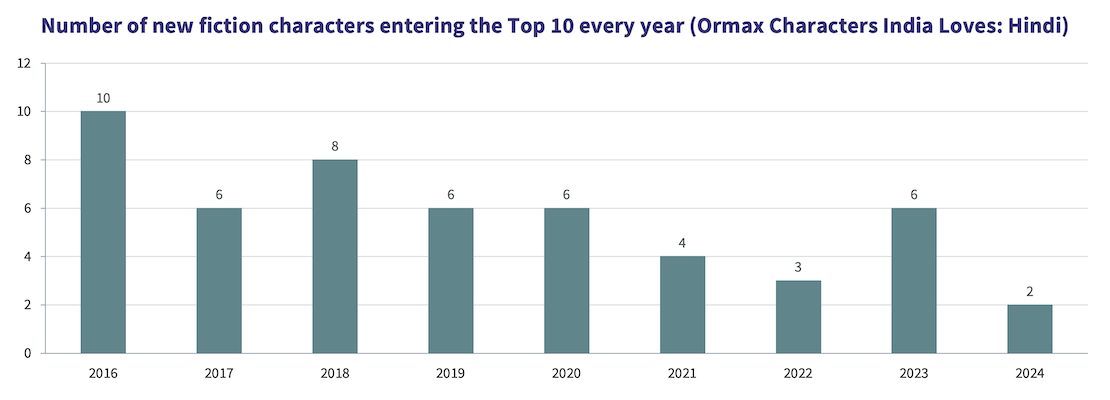


In a rapidly evolving entertainment landscape, one might assume that fresh faces and newer narratives would dominate the viewer’s imagination. But fiction content trends on linear Hindi television (Hindi GEC) tells a different story. One where audience tastes are more rooted in emotional familiarity than in change.
Over the last few years, Hindi GEC fiction content has witnessed a striking trend: longevity and legacy matter more than novelty. A closer look at the data from our monthly character popularity track Ormax Characters India Loves (OCIL) reveals that legacy characters continue to rule, even as newer characters find it increasingly hard to break through. The list of Top 10 fiction characters in any month is dominated by characters from long-running shows. The chart below captures the count of new fiction characters who entered the Top 10 in at least one month in each year since 2016. As can be seen, 2024 has set a new low on this parameter. And while 2023 may seem like an aberration, four out of the six new entries that year were characters from existing, long-running shows, rather than new shows.

This trend reflects a deeper shift in viewer behaviour: audiences are becoming less experimental and more emotionally conservative, when it comes to Hindi GEC content. They prefer to invest in characters they already have known and loved over an extended period of time.
One of the best examples of this trend is the character of Daya from Taarak Mehta Ka Ooltah Chashmah, who continues to feature in the OCIL Top 10 despite making her last appearance in the show 7.5 years ago, in September 2017 (and a fleeting appearance in an episode in August 2018). While she can be seen on the channel (Sony SAB) via reruns, there hasn’t been an original episode featuring the character all these years. Yet, Daya has featured not just in the Top 10 but even in the Top 5, and more recently, in the Top 3 fiction characters on Hindi GECs, behind only Jethalal (her on-screen husband) and Anupama!

Daya’s lasting popularity can be attributed not just to her comic timing, but also to her multifaceted role that offers a blend of humor, tradition and relatability, without slipping into the ‘television bahu’ stereotype.
But Daya’s case is not isolated. Yeh Rishta Kya Kehlata Hai contributes three characters to the current OCIL Top 10: Akshara, Naira, and Abhira, each representing a different generation within the same family tree. This kind of cross-generational relevance is rare, and speaks volumes about the show’s storytelling strength. It also reflects a smart creative approach, where generational leaps are used not to disrupt but to evolve the narrative. Instead of asking viewers to reset, the show allows them to continue a journey with characters that feel like family.

The enduring popularity of characters from shows like Taarak Mehta Ka Ooltah Chashmah, Yeh Rishta Kya Kehlata Hai, and Anupama exposes a vacuum in the Hindi GEC fiction landscape: a lack of breakout characters who can rival the cultural footprint of legacy figures like Daya and Akshara.
It’s been half a decade since Anupama emerged as the last true breakout hit. In today’s era of inertia-driven television (read more here), the timeline for the next big breakthrough remains uncertain. Until then, audiences seem content to revisit familiar faces - like the irrepressible Daya - whose legacy continues to shine, even years after she left the screen.

Venn It Happens: OTT & Linear TV audience intersection
The first edition of our new feature Venn It Happens illustrates the intersection between OTT and Linear TV audiences in India, using data from The Ormax OTT Audience Report: 2025

Ormax Mpact case study: Bandhan Mutual Fund on India Today TV
This case study, based on the integration executed by Bandhan Mutual Fund on English news channel India Today, showcases our Brand Lift measurement tool Ormax Mpact

Brand Lift measurement tool: Ormax Mpact
An overview of Ormax Mpact, a state-of-the-art Brand Lift Measurement tool designed to help marketers and advertisers evaluate the impact of their media campaigns, collaborations, and innovations
Subscribe to stay updated with our latest insights
We use cookies to improve your experience on this site. To find out more, read our Privacy Policy